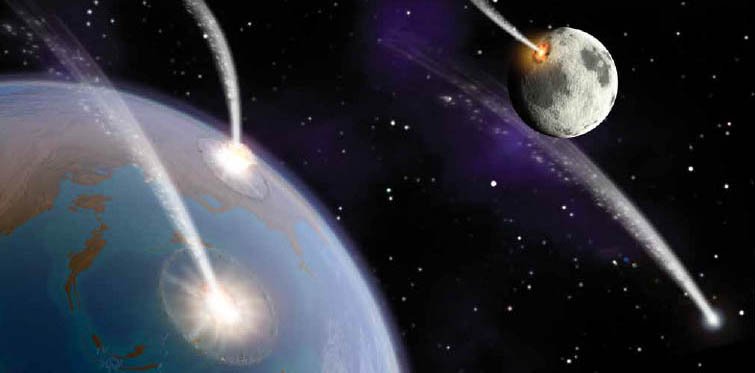
Feb. 8, 2018
Research Highlight
"Cataclysm No More": The Timing of Lunar Impacts

Artist impression of impact events on the Earth and Moon.Image credit: NASA Goddard/B. Griswold.
The impact record of the Moon can provide important insights into the history of the Earth. Evidence of ancient impacts on Earth, such as crater structures, can be difficult to identify because of turnover at the planet’s surface due to various geologic, chemical and physical processes. Because ancient craters on Earth get wiped away over time, scientists have turned to the Moon in order to identify periods of time when impacts may have been common in the Earth-Moon system.
Previous studies of the lunar impact record led to the development of a popular theory known as the ‘Late Heavy Bombardment’ (LHB), where it was thought that the entire inner solar system experienced an intense spike in impacts some 4 billion years ago. Many astrobiologists have taken an interest in this topic, because it could have major implications for the timing of the origin(s) of life on Earth.
Studies on the number, size and age of lunar craters have been undertaken, and have made use of observations from Earth, images from orbiting spacecraft at the Moon, and modelling data. However, our understanding of the lunar impact record is still limited. Recently, Nicolle E. B. Zellner (Department of Physics, Albion College) reviewed the existing information available on the topic and has presented new interpretations of the data. Her study suggests that there may not have been a cataclysmic spike in impact events 3.9 billion years ago, as suggested by the LHB theory. Instead, bombardment of the Moon may have occurred over a prolonged period lasting from roughly 4.2 to 3.4 billion years ago. The study also discusses how the new interpretation of lunar data could affect our understanding of conditions on the ancient Earth at the time of life’s origins.
The study, “Cataclysm No More: New Views on the Timing and Delivery of Lunar Impactors,” was published in the journal Origins of Life and Evolution of the Biosphere. The work was supported by the National Science Foundation’s Astronomy and Astrophysics program, the Hewlett-Mellon Fund for Faculty Development at Albion College, NASA’s Solar System Workings program, and the former NASA Lunar Advanced Science and Exploration Research (LASER) program.
Related Links:
Re-thinking a Critical Period in Earth’s History